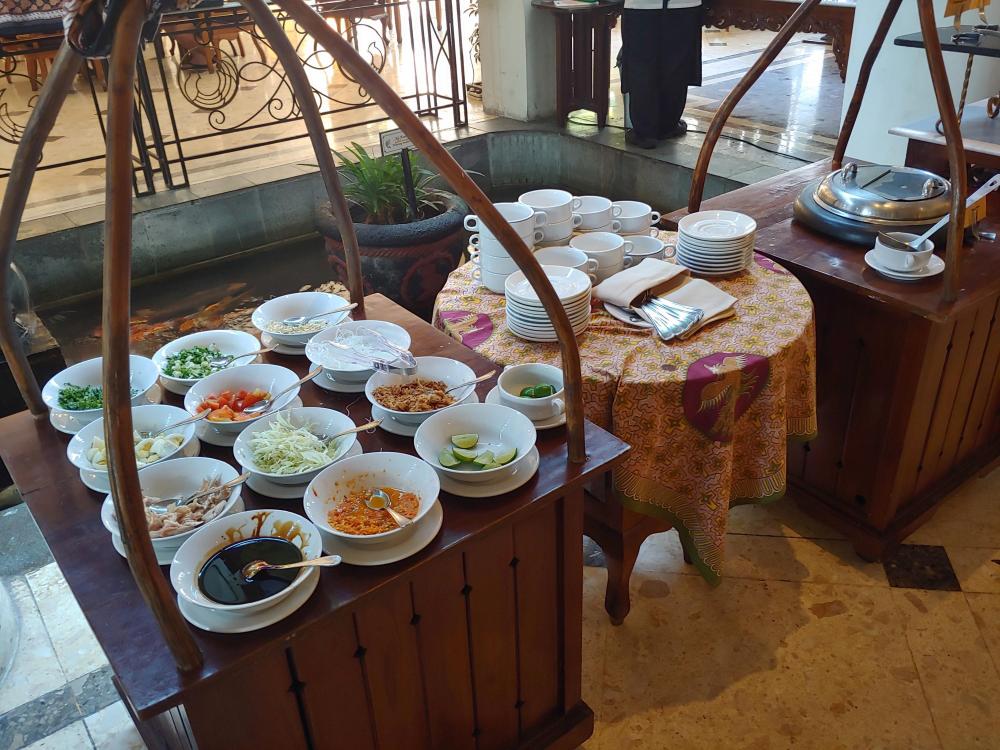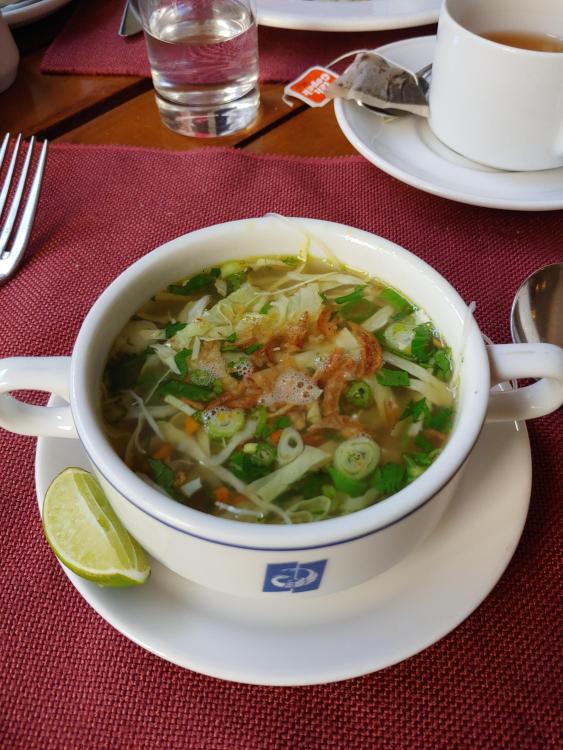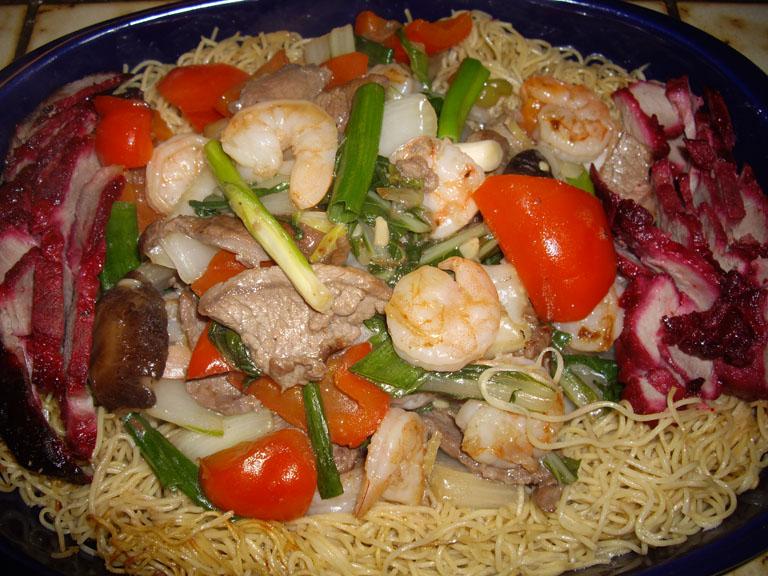Search the Community
Showing results for 'wok'.
Found 5,182 results
-
I actually can't see how a wok is great for popcorn. A flat bottomed pan will heat much more quickly and evenly over the bottom, which is what I think I want for popcorn. Like that old Revere saucepan and lid.
-
The whole water, salt, corn kernel cold start is intriguing as a seasoning mechanism. The suggestion that the result might be moist and chewy and require an oven to dry is totally off-putting. Edited to add that a wok is great for popcorn but I don’t keep the lid handy so usually default to an ancient Revere saucepan that earned its warped bottom to many batches of the stuff.
-
I use my wok: 1. Lightly boil water in the wok to remove stray flavors (optional). 2. To a dry wok, add 1/2 tsp. salt, 160 ml of kernels, and 40 ml of water. Yes, water. 3. Put wok on a small burner and turn it on 1/2-way. Swirl the wok around to evenly distribute the water and salt. (The heat will dissolve the salt into the water and the water will mostly get sucked up into the kernel, thus seasoning the popcorn from the inside!) *Only swirl the water for a minute or so.* 4. Add one, and only one, pat of butter, and enough oil to coat the kernels. 5. Turn the heat to high and gently swirl. (The water will boil out and then the temp will rise, causing the butter to foam.) 6. Place lid on wok and pop the corn. (As more pops, there will be less fluid inside the wok, so you'll have to shake it more violently as time goes by.) 7. Turn out into a large container and add water to the wok and boil it clean. Dry the wok and store. 8. Add extra butter or salt, parm, etc. as wanted. If the batch is moist and chewey, I will place it in a warm oven to steam out and dry for a few minutes. If adding parm or the flavor shakers from the store, add that immediately after turning out so the flavors will stick properly. Also, I found that popping on the small burner (or coil) makes it taste more buttery than using the large ones. IDK why. Hope this helps! -John
-
I've had this dish in several different places in Indonesia so far - several different parts of Bali and in Yogyakarta (on the island of Java). All of them have been pretty similar and I think this is pretty close to what I made most recently, although after some internet research, it seems that in other parts of Indonesia it would not be uncommon to add coconut milk. This soup is made in a similar way to Indonesian/Malaysian/Nyonya curries - you make a spice paste which is then fried in oil for a while to bring out the aromatics to which a liquid is added. The ratio of liquid to spice paste yields curry or soup. Also, like so many foods of the region, it's open to customization - some places add stuff to the soup that others won't... like hard boiled egg. One of the best versions of this soup I had was in Yogyakarta - my hotel had an Indonesian breakfast buffet and one area was a DIY soto ayam station. At the right is a cauldron of simmering soup, and everything on the left is up to you. The basics of what are added are chicken meat, shredded cabbage, mung bean noodles (aka cellophane noodles) and fried shallots. And of course, being Indonesia, there's always at least one sambal to add some heat. The base of this soup is chicken stock. My recipe below uses 4C of homemade chicken stock (unsalted). The stock gets simmered with aromatics, seasoned, and the chicken is then poached in the stock, removed, cooled and picked into shreds. Aromatics removed and the prefried spice paste (rempah) are added. It's not really practical to make a couple tablespoons of rempah, so the recipe below is for several meals for 2 people or so and the rest is frozen for later - I put it in a a ziplock bag, press into a flat sheet about 1cm thick - this way I can break off as much as I want while still frozen. Also, when I say this is for 2 people, there's one caveat - my wife is not a huge fan of soup - she loves this dish, but only has maybe 1/3 of the liquid that I'd have. So, with that being said... Rempah: About 1 inch galangal (fresh or frozen) About 1 inch ginger 5 cloves garlic 4 candlenuts About 1 heavy Tablespoon coriander seeds, dry fried until frangrant, then ground About 1 inch fresh turmeric (or about 1/2 - 3/4t ground dried turmeric) 6 shallots Blend the rempah ingredients in a blender, or ideally pound in a mortar. I typically blend 3/4 of the way, then finish it in the mortar. Fry the paste in a couple tablespoons of oil (I use rice bran oil) in a wok over medium heat to start, then turn it down to keep it from burning. Stir contantly. You know the paste is done when it looks quite dry and there is no liquid left and the oil separates back out at least partially - so it actually looks like it's frying. It should be quite fragrant. Soup: 4C chicken stock 1 stalk lemongrass, cut into 2-3 pieces and bruised 5-6 kaffir lime leaves 2-3 daun salam (Indonesian bay) leaves if dried, 5-6 if fresh 1 chicken breast Season with about 2t salt (start with less, and add until it tastes right) plus 1/2t MSG Simmer the chicken stock with the aromatics for about 5 minutes, then add the chicken breast, cover and simmer until cooked through. Remove the chicken breast to cool, and discard the aromatics Taste the remaining stock for seasoning - it should be pretty strong as the noodles will dilute it a bit. Add about 2T of the rempah to the soup and simmer for about 5 minutes. While that's going, shred the chicken breast and prep the bowls with soaked/drained cellophane noodles, cabbage, chicken, fried shallot and cilantro/green onion. Add the boiling soup to the bowls. Garnish with sambal and a slice of lime.
-
Sometimes I make steak balmoral, which consists basically of steak braised in whisly (or rather what remains of it after setting it on fire). It has a nice color, good flavor and a tender texture and, like most such preparations, you can keep it on the stove for a while if you are not ready to serve the meal (it's useful for when I'm not sure at what time the missus is going to be back from work, so I can have it ready to serve at a moments notice). For this recipe, you need a lean cut of meat (it can be pork or beef, and maybe chicken, although I'm not a fan of it), mushrooms, honey, whiskey, pepper, butter, stock and cream in undetermined quantities. You should mix the honey and the whiskey in advance. First, sautee the mushrooms with butter on a pan or a wok with crushed peppercorns. Once they are done, set aside and cook the meat. Sometimes, if I want the result to be less oily, instead of sauteeing the meat with cooking oil, I use the fat of the meat itself to coat the wok. It might be more carcinogenic, but it's less oily. Once the meat is cooked, toss in the mushrooms, pour the mixture of whiskey and honey and set it ablaze while stirring. This is the perfect time to take a picture for Instagram, but be careful not to drop the phone on the pan. After the flames die out, add the stock and cream, and stir until the texture looks good. Usually I season it with rosemary and tarragon, and maybe fresh parsley if I have it. So there you have an example of a recipe that includes whiskey and meat. Maybe it's not technically braising, since the meat is cooked before tossing whiskey on it, but it's tasty nontheless.
-
Thanks for the suggestion but I’ve checked and it’s far enough away. The outside of the oven doesn’t get any where near hot enough to possibly affect the house and the front is far enough away that it isn’t an issue. I use that 160k BTU wok burner on the bottom shelf on top of the table with no problem at all. I do have a single use fire extinguisher not pictured at hand for safety, but it’s fine. As I use it more if I do think there could be a problem I can just pull the table away more than it already is.
-
I raised the surrender flag stir frying this vegetable at home because, invariably, by the time I plate it and serve it at the table it has turned or beginning to turn the color of very dark olive green and is chewy and dry. I had a very hot wok and stir fried for just about a minute. A very sad contrast to the Google images of the dish that had a bright green color and a bit of sauce I drool on.
-
For me, the minimum diameter for a wok should be 14". barely big enough to stir fry for two. Especially if it is flat bottom. less than 14" it is just a deep skillet. I prefer a 16" wok. dcarch
-
Ah, reminds me of De Buyer by the looks. Also made in France. https://www.debuyer.com/en/products/induction-hob-special-stainless-steel-wok-stainless-steel-tube-handle https://www.francecorner.com/cook/2018-de-buyer-affinity-wok.html This one is less pricey, comes with lid and wok spatula: https://www.amazon.com/Souped-Up-Recipes-Induction-Seasoning/dp/B07RJ39JVL You may find this more recent article of interest: https://theequippedcook.com/induction-wok/
-

Cantonese White Cut Chicken 白切鸡: Poach, Steam or Sauté?
mudbug replied to a topic in China: Cooking & Baking
There's no need to use an oven to make crispy, chip like chicken skin. A little peanut oil or rice bran oil (or your favorite frying oil) in the bottom of a wok will do the trick. Dry the chicken skin, lightly fry util crisp, sprinkle with salt and MSG. DELISH and oven free. -

Cantonese White Cut Chicken 白切鸡: Poach, Steam or Sauté?
mudbug replied to a topic in China: Cooking & Baking
There's no need to use an oven to make crispy, chip like chicken skin. A little peanut oil or rice bran oil (or your favorite frying oil) in the bottom of a wok will do the trick. Dry the chicken skin, lightly fry util crisp, sprinkle with salt and MSG. DELISH and oven free. -

Cantonese White Cut Chicken 白切鸡: Poach, Steam or Sauté?
liuzhou replied to a topic in China: Cooking & Baking
Is it? Not in many Chinese kitchens. Most people don't have the equipment. You can't cook a whole, submerged chicken in a domestic wok, which is all many homes have. A wok and a rice cooker is all most people have. I don't have a pan large enough and I'm not going to buy one just for something I might cook once a year. Especially when I can buy the dish so easily, if I choose. But if I did buy a suitable pan, where would I keep it? Chinese home kitchens tend to be smaller than what you may be used to. Also. it uses a lot of water. Once to cover the chicken to poach, then for the ice bath which also has to cover the bird. Where do I get that much ice? I'm not saying no one makes it, but few do. I don't think any of my friends do. -
Pictorial: Chicken w/Lemon Grass Black Bean Sauce
xiaobao12 replied to a topic in China: Cooking & Baking
thanks for the responses. hzrt, although I do think that using a skillet gives me more surface area to play with, I have to use a lot more oil than if I were to use a wok. I guess this is the trade off right? -
Hi Elsie and Leslie, I have been cooking beef cheeks for a few woks with spectacular results. 9 hours at 81 degrees C eliminates the long wait and I reduce the bag juices to a glaze type consistency and serve on a bed of mash. Look here for a photo ... http://forums.egullet.org/topic/144603-dinner-2013-part-2/?p=1911678 Let me know if you want the entire recipe. Simon
-
When I'm not willing to fire my 1910 solid-fuel cookstove, I use a 2-burner propane rig like this: http://www.whatsitworth.net/cse/images/2013/01/19/226/1918-antique-glenwood-no2-cast-iron-double-burner-propanegas-hot-plate-stove_1.jpg A 20-lb bottle lasts me 6-9 months, and it hasn't set off the CO detector yet. An advantage of these is that, with very little effort, you can pimp them out to do >100K Btu for wokking--but do that OUTSIDE.
-
you wont be getting far with an electric wok. and the coating will sublimate at the temps you are looking for. there are induction wok 'burners': the type of wok you want is the one at the end of this vid: sort of blacked, Ming Tsai ( simply ming ) used one with an induction SS wok on one of his earlier shows. that was years ago and that model cost $ 10 k back then. then there is this: http://www.amazon.com/Adcraft-IND-WOK120V-Commercial-Induction-Cooker/dp/B004UI882A http://www.amazon.com/dp/B001H1021I?tag=wat013-20 if the price of these dropped a bit AND the circular 'depression' fit a good steel wok well, and there were enough watts, well, there it is!
-
Ok. I've read all the posts in this thread & I'm still not sure what wok to buy. We have an induction stove top. I've seen some woks that purport to work on these, but I'm suspicious. We do have a large gas BBQ which I'm sure would probably work, but that means going outside to cook. OK in summer, but not in winter. I'm leaning towards an electric wok. This most powerful ones I can find are rated at 2200 watts. Enough power? Don't know how this translates into BTU's. Also, any advice/ experience with non-stick coatings for woks. I can't find any high power electric one that don't have a non-stick coating. I would appreciate any & all advice anybody can give me.
-
Foil-lined wok , with the food on top of chopsticks going across the top, works pretty well for me.
-
Practise tossing food in your wok with a plate of peanut shells outside, or similar. That way you won't risk wasting food if you happen to toss it all over your hob.
-
The guy gave me a wok to take home with me and a 'spatula/ladle' and I bought a packet of salt to practice 'tossing' it. When I went back to the restaurant I just couldn't do it with out lifting off the 'nest' because I had been practicing walking around my apartment with the wok in the air. They then made be do it on the wok cooker with chopped cabbage. It was difficult. The kitchen was spartan and the weather was hot. But I soon managed to get into the required rhythm. Because that's what it is.....developing muscle memory to remember this rhythm. Shame is that now I am home I don't have cooking equipment to do this. I'm planning on rectifying this though.
-
Good descriptions, Keith and Ader, on how "NOT" to toss. That's exactly what I do at home, with my rounded-bottom wok and electric range, without a wok-ring. Can't stand them, and I think keeping the wok ON maintains the heat. I need to check out the other videos in the series Chris posted, especially the salt and pepper squid...
-
Do not lift your wok off the "nest" (I don't know the correct term for it either). To toss food in a wok, push it away from you then jerk it back suddenly. The food will hit the side of the pan and fly into the air. Just as you jerk it back, push it forward again to catch the food.
-
I noticed that as well. He was quite adept at the tossing. However, may I just add this one thing? I did spend some time working in a restaurant in China and I was learning how to 'toss'. The wok I was using was I would say larger than the one in the above video. Anyway, I was stir frying away as best I could and lifting the wok off of it's 'nest' (if that's a correct enough term?). And the guy who run the restaurant told me not to lift it up but more slide it towards you and back to it's housing/nest. The wok 'spatchula' was also used to kind of push the contents away from yourself to the other end of the wok and then tossed back as one moved the wok towards oneself. Of course, Kingkristo's set up wouldn't be suitable for this as are most western gas cookers. The guy showing me how to do it pointed out that in Chinese restaurants many of the woks are so big you'd never lift it up and 'toss'. I'm just saying what he told me but maybe in home cooking situations they do lift the woks up of the 'nest'?
-
Kingchristo: I use packaged dry wheat /egg noodles when I can't get fresh. The dried ones, put in boiling water until, as Mark said, just done. Drain and shock with cold water. Drain really well. I like to let mine sit in the fridge, barely covered for several hours or even a day before using them. The noodles are chilled, firm, and easier to stir fry. For what I call "plain noodles", I heat up the wok until very hot, and it is possible to do this even with my electric coil stove. Add oil and coat the wok well. Sprinkle in salt (and chopped garlic if you wish) Add a layer of noodle, spread it over the surface, and let it brown a bit. Flip the noodles over and do the other side. Then, I'd use chopsticks to loosen the noodles, and continue cooking until all the noodles are heated thru'. This way, I have a mixture of crisp and soft. At this time, you can add a splash of soy sauce, or, for me, a drizzle of sesame seed oil. To me, this is "plain chow mein". I also remember this version when we visited the northeast Yorkshire area. This version is versatile as I can top the noodles with a mix of stir-fried vegetables, with meat, or just stir-fried beansprouts and green onions. I also use my crepe pan to make a noodle "pancake" - crispy on the outside but soft on the inside. Then a mix of meat, vegetables, and sauce is poured over the top. Or you can make lo-mein, where everything is mixed in together. I am like you, I often like to replicate a dish I've eaten in a restaurant. Authentic? Who knows unless we've eaten in every corner of China! As everyone has mentioned, every place has their own version. If you can post a pictures, perhaps one of us can identify it as from "our region" I hope this will help you! Meanwhile, here's what I made for supper one night last week. Probably called Cantonese Chow Mein because that's where I am from.
-
Strange...what we grow up eating and exposed to is what we call "real Chinese". I wouldn't have thought kingchristo's dish was real if I hadn't had a salt and pepper chicken dish similar to his at an "authentic" Chinese restaurant here. At least, my students from mainland China all love this place and says it's "real Chinese food"... As for deep frying in a wok, it WOULD be hazardous with the set up kingchristo uses. But, you were sure adapt at "wokking" with the tossing! I've been cooking for longer than any of you, I think, and I still can't "toss" like that! I blame it on my short stature. BTW: Thanks for sharing your video, Chris, and welcome to the China forum!











